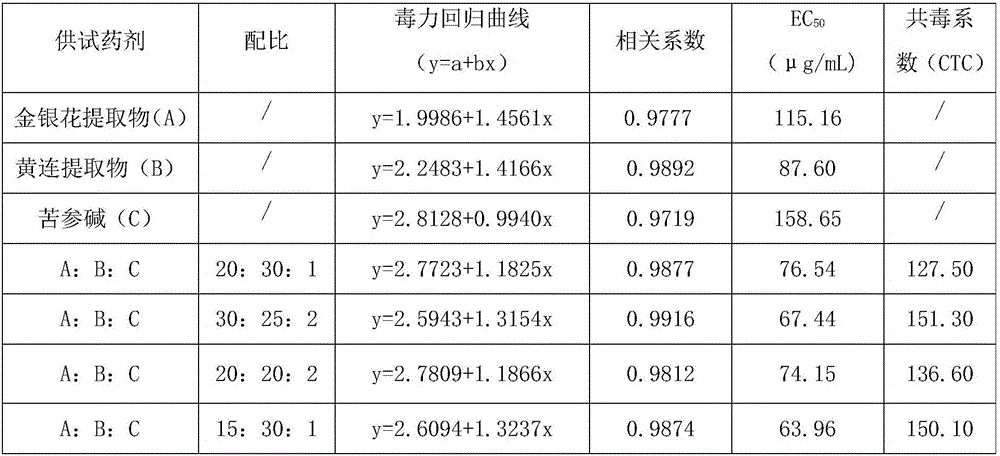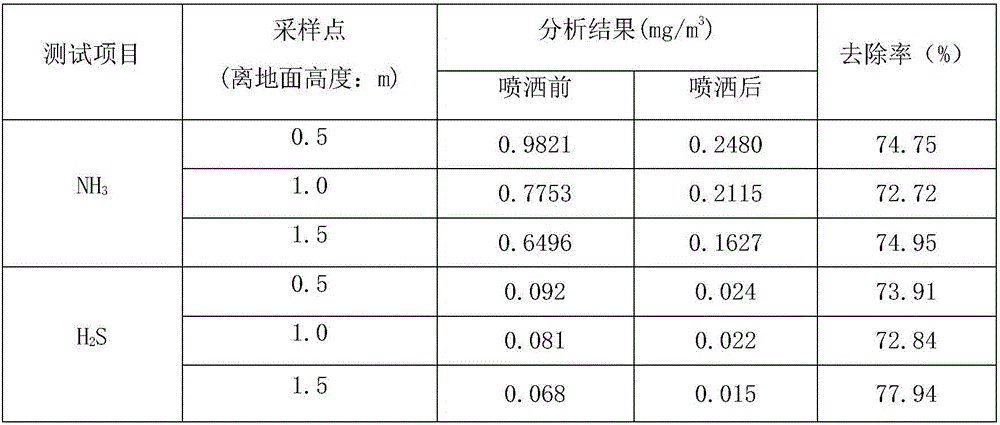Honeysuckle-flower-containing plant-derived deodorizer
A honeysuckle extract, plant-derived technology, applied in the directions of plant growth regulators, deodorants, biocides, etc., can solve the problems of user inconvenience, low concentration, high price, and achieve safe use, less dosage, and high control efficiency. Effect
- Summary
- Abstract
- Description
- Claims
- Application Information
AI Technical Summary
Problems solved by technology
Method used
Image
Examples
Embodiment 1
[0032] Example 1: Preparation of Honeysuckle Extract and Coptis Rhizome Extract
[0033] 1.1 Preparation method of honeysuckle extract:
[0034] (1) The honeysuckle raw material is dried, crushed through a 40-mesh sieve, added deionized water to decoct and extract 3 times, and the amount of deionized water added each time is 10 times the amount (by weight) of the raw material, and the decoction time is 10 times each time. After 1.5 hours, combine the decoctions obtained each time, and filter through a 350-mesh sieve to obtain the initial filtrate.
[0035] (2) Use an ultrafiltration membrane with a cut-off value of 4000 Daltons to perform ultrafiltration treatment on the primary filtrate to obtain a refined filtrate.
[0036] (3) Concentrate the fine filtrate with a reverse osmosis membrane with a pore size of 0.001 micron to obtain a concentrate.
[0037] (4) Dry the concentrated solution in a 50°C electric constant-temperature blast drying oven to obtain the honeysuckle ex...
Embodiment 2
[0041] Example 2: Indoor Toxicity Determination of Honeysuckle Extract, Coptis Rhizoma Extract, Matrine and Their Mixtures to Aspergillus flavus
[0042] After pre-testing to determine the effective inhibitory concentration range of each extract prepared in Example 1, the honeysuckle extract, Coptis chinensis extract, matrine and their mixture were treated with 5 dose gradients according to the active ingredient content, and a clear water control was set. . Refer to the "Pesticide Indoor Bioassay Test Guidelines for Fungicides", and use the mycelium growth rate method to determine the toxicity of the agent to Aspergillus flavus. After 72 hours, the colony diameter was measured by the cross method, and the net growth rate of each treatment was calculated for mycelial growth inhibition rate.
[0043] DPS data processing software was used for statistical analysis, the mycelia growth inhibition rate was converted into a probability value (y), the concentration of the drug solutio...
Embodiment 3
[0048] Example 3: 5.7% (honeysuckle extract·coptidis extract·matrine) plant-derived deodorant
[0049] Weigh 3.5% of honeysuckle extract, 2.0% of Coptis chinensis extract, 0.2% of matrine, and 8.0% of sodium lauryl sulfate by weight percentage. 5.7% (honeysuckle extract · coptis extract · matrine) plant-derived deodorant.
[0050] This embodiment is applied to the deodorization test of municipal solid waste. Monitoring conditions: Put a pile of about 250kg of domestic garbage that produces stench in a closed room of 12m×5m×3.5m, and arrange 3 sampling points evenly at about 0.6m around the garbage, and the height of the sampling points from the ground is 0.5m , 1.0m, 1.5m, the deodorant is diluted 80 times with tap water and sprayed evenly on the surface of the garbage. The surface is thoroughly sprayed as the standard, and then sprayed again at intervals of 2 hours, a total of two sprays. Determination of NH in stench before the first spraying and 60 minutes after the secon...
PUM
 Login to View More
Login to View More Abstract
Description
Claims
Application Information
 Login to View More
Login to View More - R&D
- Intellectual Property
- Life Sciences
- Materials
- Tech Scout
- Unparalleled Data Quality
- Higher Quality Content
- 60% Fewer Hallucinations
Browse by: Latest US Patents, China's latest patents, Technical Efficacy Thesaurus, Application Domain, Technology Topic, Popular Technical Reports.
© 2025 PatSnap. All rights reserved.Legal|Privacy policy|Modern Slavery Act Transparency Statement|Sitemap|About US| Contact US: help@patsnap.com



